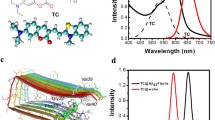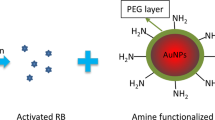Abstract
The enzyme cleaving the beta-site amyloid precursor protein (BACE1) is a prime therapeutic target for treatment of Alzheimer’s disease (AD). Hence, improved high-throughput methods for probing the activity of BACE1 are crucial with respect to the discovery of novel drugs for treatment and prevention of AD. We describe a graphene oxide (GO)-based fluorescent platform for the determination of BACE1 activity and screening of its inhibitors. It is found that covalent linkage of the fluorescein isothiocyanate (FITC)-labeled enzyme substrate (of sequence GTEEISEVNLDAEFRHDSGYKK) to GO results in quenching of the FITC fluorescence, but that on peptide cleavage by BACE1, FITC is released from the GO surface and fluorescence is restored. In contrast to other fluorescent assays, the method presented here shows much higher quenching efficiency and sensitivity, and it can be used at pH value of 4.5 where BACE1 exhibits higher activity. The inhibition of BACE1 activity by a potential inhibitor results in retarded fluorescence recovery. The half-maximum inhibition value of a well-known BACE1 inhibitor was found to be 82.7 nM, which is in agreement with the value reported earlier. In our perception, this method represents a valuable tool for screening of BACE1 inhibitors and discovery of AD drugs in a high-throughput screening format using microplate readers.

Covalent immobilization of a fluorescently labeled substrate for the beta-site amyloid precursor protein (BACE1) on graphene oxide (GO) induces fluorescence quenching. Peptide cleavage by BACE1 leads to the release of FITC from the GO surface; consequently, an enhanced fluorescence signal from FITC is observed





Similar content being viewed by others
References
Hardy J, Selkoe DJ (2002) The amyloid hypothesis of Alzheimer’s disease: progress and problems on the road to therapeutics. Science 297:353–356
Walsh DM, Klyubin I, Fadeeva JV, Cullen WK, Anwyl R, Wolfe MS, Rowan MJ, Selkoe DJ (2002) Naturally secreted oligomers of amyloid beta protein potently inhibit hippocampal long-term potentiation in vivo. Nature 416:535–539
Vassar R, Kuhn P-H, Haass C, Matthew EK, Rajendran L, Wong PC, Lichtenthaler SF (2014) Function, therapeutic potential and cell biology of BACE proteases: current status and future prospects. J Neurochem 130:4–28
Ghosh AK, Osswald HL (2014) BACE1 (b-secretase) inhibitors for the treatment of Alzheimer’s disease. Chem Soc Rev 43:6765–6813
Menting K, Claassen JAHR (2014) β-secretase inhibitor; a promising novel therapeutic drug in alzheimer’sdisease. Front Aging Neurosci 6:1–9
Kennedy ME, Wang WY, Song LX, Lee J, Zhang LL, Wong G, Wang LY, Parker E (2003) Measuring human beta-secretase (BACE1) activity using homogeneous time-resolved fluorescence. Anal Biochem 319:49–55
Mancini F, De Simone A, Andrisano V (2011) Beta-secretase as a target for Alzheimer’s disease drug discovery: an overview of in vitro methods for characterization of inhibitors. Anal Bioanal Chem 400:1979–1996
Mancini F, Naldi M, Cavrini V, Andrisano V (2007) Multiwell fluorometric and colorimetric microassays for the evaluation of beta-secretase (BACE-1) inhibitors. Anal Bioanal Chem 388:1175–1183
Choi Y, Cho Y, Kim M, Grailhe R, Song R (2012) Fluorogenic quantum dot-gold nanoparticle assembly for beta secretase inhibitor screening in live cell. Anal Chem 84:8595–8601
Ellis CR, Shen J (2015) pH-dependent population shift regulates BACE1 activity and inhibition. J Am Chem Soc 137:9543–9546
Kochmann S, Hirsch T, Wolfbeis OS (2012) Graphenes in chemical sensors and biosensors. Trac-Trend Anal Chem 39:87–113
Liu Z, Liu B, Ding J, Liu J (2014) Fluorescent sensors using DNA-functionalized graphene oxide. Anal Bioanal Chem 406:6885–6902
Pérez-López B, Merkoçi A (2012) Carbon nanotubes and graphene in analytical sciences. Microchim Acta 179:1–16
Feng L, Wu L, Qu X (2013) New horizons for diagnostics and therapeutic applications of graphene and graphene oxide. Adv Mater 25:168–186
Wang L, Pu K-Y, Li J, Qi X, Li H, Zhang H, Fan C, Liu B (2011) A graphene–conjugated oligomer hybrid probe for light-up sensing of lectin and Escherichia coli. Adv Mater 23:4386–4391
Wang Y, Li Z, Hu D, Lin C-T, Li J, Lin Y (2010) Aptamer/graphene oxide nanocomplex for in situ molecular probing in living cells. J Am Chem Soc 132:9274–9276
Anfossi L, Calza P, Sordello F, Giovannoli C, Di Nardo F, Passini C, Cerruti M, Goryacheva IY, Speranskaya ES, Baggiani C (2014) Multi-analyte homogenous immunoassay based on quenching of quantum dots by functionalized graphene. Anal Bioanal Chem 406:4841–4849
Li F, Pei H, Wang L, Lu J, Gao J, Jiang B, Zhao X, Fan C (2013) Nanomaterial-based fluorescent DNA analysis: a comparative study of the quenching effects of graphene oxide, carbon nanotubes, and gold nanoparticles. Adv Funct Mater 23:4140–4148
Lu ZS, Chen XJ, Wang Y, Zheng XT, Li CM (2015) Aptamer based fluorescence recovery assay for aflatoxin B1 using a quencher system composed of quantum dots and graphene oxide. Microchim Acta 182:571–578
Deng XH, Tang H, Jiang JH (2014) Recent progress in graphene-material-based optical sensors. Microchim Acta 406:6903–6916
He S, Song B, Li D, Zhu C, Qi W, Wen Y, Wang L, Song S, Fang H, Fan C (2010) A graphene nanoprobe for rapid, sensitive, and multicolor fluorescent DNA analysis. Adv Funct Mater 20:453–459
Zhang Y, Tang L, Yang F, Sun Z, Zhang G-J (2015) Highly sensitive DNA-based fluorometric mercury(II) bioassay based on graphene oxide and exonuclease III-assisted signal amplification. Microchim Acta 182:1535–1541
Shi J, Guo J, Bai G, Chan C, Liu X, Ye W, Hao J, Chen S, Yang M (2015) A graphene oxide based fluorescence resonance energy transfer (FRET)biosensor for ultrasensitive detection of botulinum neurotoxin a(BoNT/a) enzymatic activity. Biosens Bioelectron 65:238–244
Song E, Cheng D, Song Y, Jiang M, Yu J, Wang Y (2013) A graphene oxide-based FRET sensor for rapid and sensitive detection of matrix metalloproteinase 2 in human serum sample. Biosens Bioelectron 47:445–450
Tian J, Ding L, Wang Q, Hu Y, Jia L, Yu J, Ju H (2015) Folate receptor-targeted and cathepsin B-activatable nanoprobe for in situ therapeutic monitoring of photosensitive cell death. Anal Chem 87:3841–3848
Kong WH, Sung DK, Kim KS, Jung HS, Gho EJ, Yun SH, Hahn SK (2012) Self-assembled complex of probe peptide - E. Coli RNA I conjugate and Nano graphene oxide for apoptosis diagnosis. Biomaterials 33:7556–7564
Gu X, Yang G, Zhang G, Zhang D, Zhu D (2011) A new fluorescence turn-on assay for trypsin and inhibitor screening based on graphene oxide. ACS Appl Mater Interfaces 3:1175–1179
Zhang M, Yin B-C, Wang X-F, Ye B-C (2011) Interaction of peptides with graphene oxide and its application for real-time monitoring of protease activity. Chem Commun 47:2399–2401
Feng T, Feng D, Shi W, Li X, Ma H (2012) A graphene oxide-peptide fluorescence sensor for proteolytically active prostate-specific antigen. Mol BioSyst 8:1441–1445
Mullan M, Crawford F, Axelman K, Houlden H, Lilius L, Winblad B, Lannfelt L (1992) A pathogenic mutation for probable alzheimers’ disease in the APP gene at the N-terminus of beta-amyloid. Nat Genet 1:345–347
Yi X, Hao Y, Xia N, Wang J, Quintero M, Li D, Zhou F (2013a) Sensitive and continuous screening of inhibitors of β-site amyloid precursor protein cleaving enzyme 1 (BACE1) at single SPR chips. Anal Chem 85:3660–3666
Martin MM, Lindqvist L (1975) The pH dependence of fluorescein fluorescence. J Lumin 10:381–390
Yi X, Han H, Zhang Y, Wang J, Zhang Y, Zhou F (2013b) Amplified voltammetric characterization of cleavage of the biotinylated peptide by BACE1 and screening of BACE1 inhibitors. Biosens Bioelectron 50:224–228
Xia N, Zhang Y, Guan P, Hao Y, Liu L (2015) A simple and label-free electrochemical method for detection of beta-site amyloid precursor protein cleaving enzyme and screening of its inhibitor. Sensors Actuators B Chem 213:111–115
Andrau D, Dumanchin-Njock C, Ayral E, Vizzavona J, Farzan M, Boisbrun M, Fulcrand P, Hernandez JF, Martinez J, Lefranc-Jullien S, Checler F (2003) BACE1- and BACE2-expressing human cells. J Biol Chem 278:25859–25866
Acknowledgments
Partial support of this work by the National Natural Science Foundation of China (Nos. 21205003, 21305004), the Joint Fund for Fostering Talents of National Natural Science Foundation of China and Henan Province (U1304205) and the Program for Science and Technology Innovation Talents at the University of Henan Province (15HASTIT001) is gratefully acknowledged.
Author information
Authors and Affiliations
Corresponding author
Electronic supplementary material
ESM 1
(DOC 936 kb)
Rights and permissions
About this article
Cite this article
Liu, L., Xia, N. & Yu, J. A graphene oxide-based fluorescent scheme for the determination of the activity of the β-site amyloid precursor protein (BACE1) and its inhibitors. Microchim Acta 183, 265–271 (2016). https://doi.org/10.1007/s00604-015-1647-9
Received:
Accepted:
Published:
Issue Date:
DOI: https://doi.org/10.1007/s00604-015-1647-9




